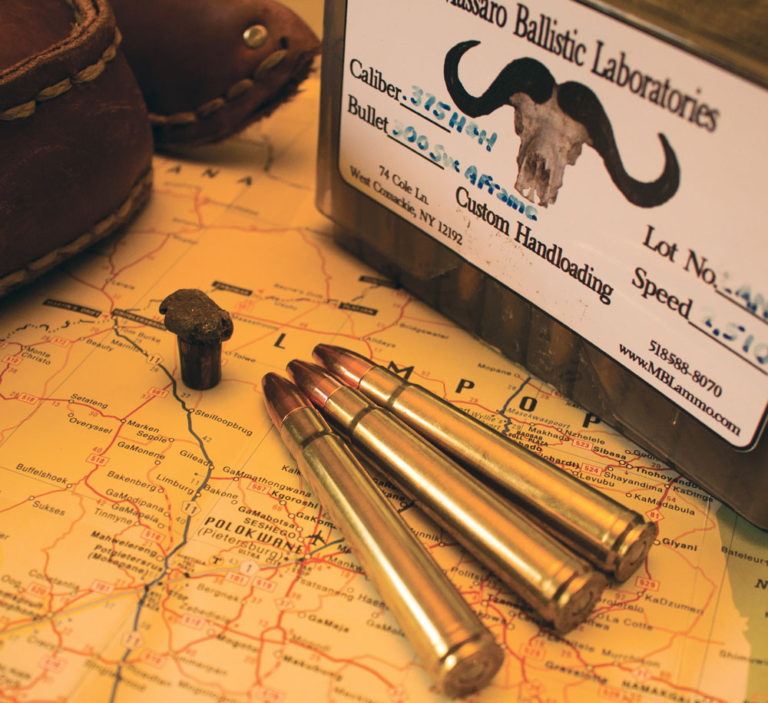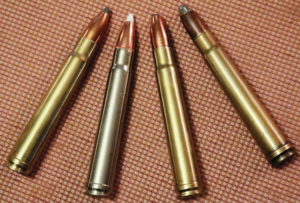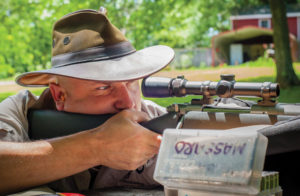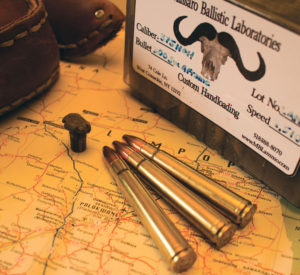

The .375 H&H Magnum is by far one of the most versatile cartridges ever developed.

“We’re all out of cover, Phil. You either take him from here or pass. How well do you know that rifle?”
The half-mile leopard crawl, which resulted in bloody knees and elbows, had come to its end. I looked through the binoculars at the herd of eland, and I could clearly see the biggest of three bulls at the right side of the herd. I was lying prone among the cactus and thorns, leaning my shoulder against a rock-hard termite mound that dotted the plain of the Orange Free State of South Africa. The eland were easy enough to see; the problem was the expanse of wide-open ground between us.
“I’d put them at 400, no?”
“Unfortunately, I agree.”
The rifle couldn’t have been rested any steadier. The forend of the Winchester Model 70 was nestled in an impromptu bundle formed from my safari jacket, and when I settled into the rifle, I was wedged against the termite mound. I turned the scope all the way up, adjusted the hold for drop at 400 yards and gave another adjustment for wind. When the smooth squeeze of the trigger turned into that familiar, violent explosion, it wasn’t long before I heard the sweet sound of bullet hitting bone. The eland took the 300-grain Swift A-Frame right on the point of the shoulder, and with one coup de grace, he was in the salt. That Model 70 was chambered in .375 H&H Magnum, a safari classic.
The .375 Holland & Holland Belted Magnum was released in 1912, and it was classified as a “medium bore,” whereas with the bullets and powders of today, I’d lean toward calling it a “big bore.” The initial loadings used a 235-grain bullet at 2,800 fps, a 270-grain bullet at 2,650 fps and a 300-grain bullet at 2,500 fps. While the velocities haven’t changed radically, the bullet weights and construction sure have.
The .375 H&H made quite the reputation early on, and with good reason. The lighter 235-grain bullets made a good long-range choice, especially for lighter game, and as optics in the early part of 20th century weren’t popular, that load shot plenty flat enough for any hunter. The 235s didn’t have the best sectional density, but they worked fine for the smaller antelope and deer species. The early cup-and-core 270-grain bullets handled the larger antelope—like eland, kudu and sable—without destroying too much meat.
The beauty of the .375 H&H, especially in the huge, mixed bag safaris, was that the 300-grain softpoints and solids would just as handily dispatch lion and buffalo as they would the enormous elephant. The penetration of these bullets was unparalleled, and while they lacked the energy figures and the frontal diameter of the big .450s, they were much easier for the visiting sportsman to shoot effectively. The flexibility of the loads made a great choice for the one-gun world traveler. Alaska’s biggest bears are easily handled by the .375 H&H, as was (in the day) the giant gaur of India and even the tiger.
 Several of the more prominent hunters have embraced the .375 H&H as their preferred tool—Harry Manners and Wally Johnson come quickly to mind, and Finn Aagaard came to rely on a Winchester 70 in .375 during his days in Kenya. In my own experience, PH Terry Calavrias guided me in the Selous Reserve of Tanzania, and he too carried a Winchester 70 in .375 H&H, without a worry in the world.
Several of the more prominent hunters have embraced the .375 H&H as their preferred tool—Harry Manners and Wally Johnson come quickly to mind, and Finn Aagaard came to rely on a Winchester 70 in .375 during his days in Kenya. In my own experience, PH Terry Calavrias guided me in the Selous Reserve of Tanzania, and he too carried a Winchester 70 in .375 H&H, without a worry in the world.
Why? What makes it such a logical choice, when there are so many cartridges that have come and gone in the last 103 years? Surely there are better cartridges available, right?
Well, that’s a rather subjective question, but I feel comfortable saying this: Everything that the .30-06 Springfield has been to the North American continent, the .375 H&H is and will continue to be for the African continent. Let’s take a closer look at the ballistic performance and benefits of the most famous African cartridge.
The .375 was one of the first cases to wear what would become the hallmark of magnum cases: that little belt of brass. Many people believe that the belt enhances the strength of case, but that isn’t its purpose. Holland & Holland designed that belted case to give positive headspacing in a case that had a very small shoulder (as the rimmed cases do), without the feeding problems associated with rimmed cartridges in a bolt-action rifle magazine. With a case that headspaces off the belt at the rear, the shoulder angle is virtually inconsequential, so the .375 H&H is designed to feed very smoothly—an invaluable asset when pursuing dangerous game.
The 300-grain, .375-inch diameter bullet has an SD of .305, making it a sound choice for dangerous game work (an SD figure of .300 or higher is generally accepted as a good weight for the largest mammals). The .375 pushes these bullets to 2,500-2,600 fps, depending on your rifle and the ammunition manufacturer, but that velocity gives a fantastic balance of deep penetration, as well as that shooter-friendly recoil level that the .375 H&H is famous for.
The ability to place a bullet in the right spot is invaluable, and many PHs prefer a client that shoots a .375 H&H to one who is uncomfortable with a .416 or .458 caliber rifle. My wife, Suzie, at 5 foot 3 inches, shoots her .375 H&H very well, and has no problem hunting with her Winchester.
 Today’s bullets make the venerable cartridge better than it has ever been. If the cup-and-core bullets of the early 20th century helped the .375 gain that reputation, the bonded-core and mono-metal bullets of today will guarantee that it sees another century of duty.
Today’s bullets make the venerable cartridge better than it has ever been. If the cup-and-core bullets of the early 20th century helped the .375 gain that reputation, the bonded-core and mono-metal bullets of today will guarantee that it sees another century of duty.
There are some “middle ground” 250-grain bullets, like the Sierra Game King boat-tail spitzer, and the 260-grain Nosler AccuBond, as well as some heavyweight choices like the 350-grain Barnes TSX and a pair of Woodleigh softpoint and solid bullets in 350 grains.
In 300-grain choices, the North Fork bonded semi-spitzer will ruin a buffalo’s day, and the North Fork 300-grain flat point will cleanly handle any elephant walking today. The 300-grain Nosler Partition and its bonded-core cousin, the Swift A-Frame, make a good choice for an all-around load in the H&H case. The .375 H&H comes in a rifle that is affordable when compared to the double rifles, and most manufacturers have chambered for it at one time or another.
I’ve used the .375 H&H to take smaller antelope in Africa, like the steenbok, springbok and impala, as well as warthog and eland. I’ve also used it to take a huge-bodied bison on the Great Plains and for caribou in the Tioga of Quebec. It makes a great choice for bear of any color or species. I can honestly say that I’ve never lost an animal that I pointed my .375 H&H at, and I’m not done hunting with it by any stretch of the imagination.
This article appeared in the June 2015 issue of Gun Digest the Magazine.

Next Step: Get your FREE Printable Target Pack
Enhance your shooting precision with our 62 MOA Targets, perfect for rifles and handguns. Crafted in collaboration with Storm Tactical for accuracy and versatility.
Subscribe to the Gun Digest email newsletter and get your downloadable target pack sent straight to your inbox. Stay updated with the latest firearms info in the industry.

![Best Concealed Carry Guns In 2025 [Field Tested] Wilson Combat EDC X9S 1](https://gundigest.com/wp-content/uploads/Wilson-Combat-EDC-X9S-1-324x160.jpg)


![Best 9mm Carbine: Affordable PCCs [Tested] Ruger Carbine Shooting](https://gundigest.com/wp-content/uploads/Ruger-Carbine-Shooting-100x70.jpg)
![Best AR-15: Top Options Available Today [Field Tested] Harrington and Richardson PSA XM177E2 feature](https://gundigest.com/wp-content/uploads/Harrington-and-Richardson-PSA-XM177E2-feature-100x70.jpg)

Harry Manners one of the last of the old time elephant hunters used the .375 and considered it entirely adequate for elephants. Jack O’Connor used it for really big and dangerous game and wrote of its outstanding accuracy.